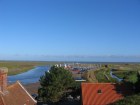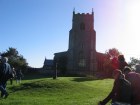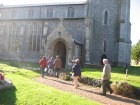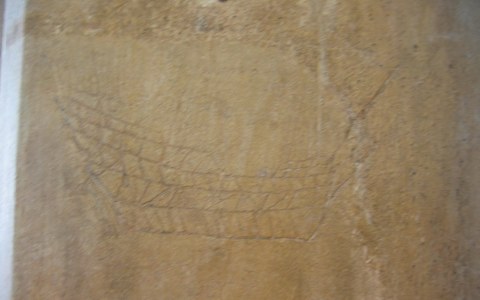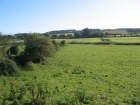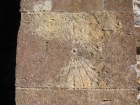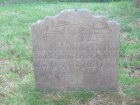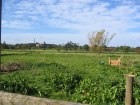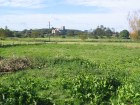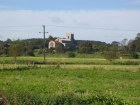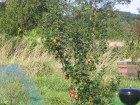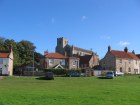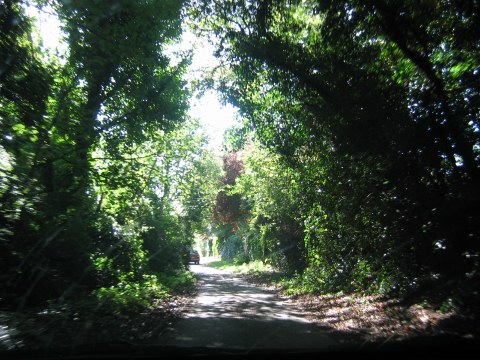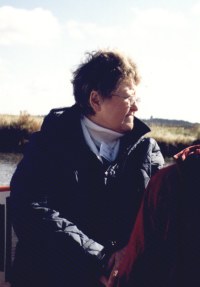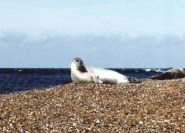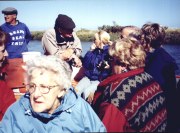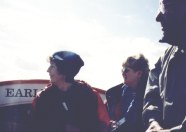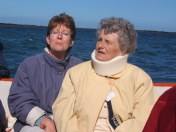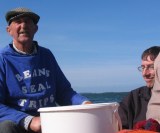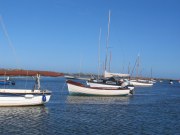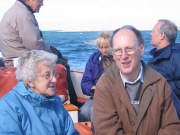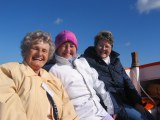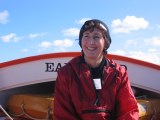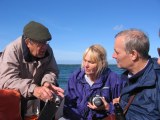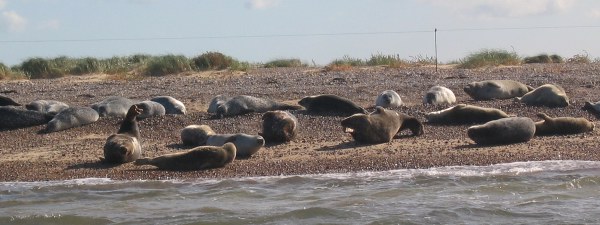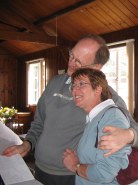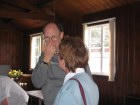You are here: home > 2004 Powditch Gathering > Sunday 19 September 2004
|
||||||||||||||||||
 Morston Church
|
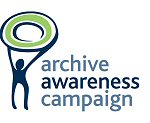 |
|||||||||||||||||
|
||||||||||||||||||
(Guided Tour of Blakeney, Wiveton and Cley)
Sunday morning like the two previous days was sunny but windy, and we all began the day’s events
by meeting on the quay at Blakeney, where we were met by local historians John and Pam Peake,
who were going to take us on a conducted tour of that village, plus those of nearby Wiveton and
Cley; all of which had been where Powditch family members had lived from the early 1500s through
to the 1600s. With everyone armed with John and Pam's excellent set of hand-out maps and
information sheets, we started our discovery trail.
First of all, we climbed up fairly steep concrete steps to the top of a nearby hummock, close to the
remains of the old Guildhall. The viewpoint was excellent, especially as the day was sunny, and in
return we were treated to a wonderful view over the harbour of Blakeney, and out to the Sea beyond,
as well as to that part of the coastline the Powditchs' must have known so well.
Here, on top of the hummock, John began his talk about the historic town, its past inhabitants, their
occupations etc, and the association between Blakeney, its shipping and past members of the
Powditch family together with other well-documented local families. Although there was a cool early-
morning's breeze, everyone was rooted to the spot, listening with great interest to John and Pam's
in-depth knowledge of the area. Later we returned down the steps to our cars, and then all followed
John and Pam on the next leg of our journey; this time to the green opposite our venue - Wiveton
Church.
The sun, although it was by now shining very strongly, still was too early in the sky to have dried up
the morning’s heavy dew, so it was with wet shoes we entered the Church, having walked over the
lush grass of the green and churchyard. Inside the building John and Pam treated us to a veritable
feast of information on the history of the building and of those who worshipped here in years gone
by, and mariners, parishioners, priests and historical families, were mentioned. Graveslabs and
brasses were examined, and names discussed, whilst a recent find of part of an old window -
which had apparently been blocked up for many years - was also a topic of conversation.
Of greater interest to everyone however, were the many examples of scratchings or carvings, that,
in the majority, had been made on the walls and pillars in medieval days in the Church. John
referred to the scratchings as ‘graffiti’, and he highlighted their existence to us when he showed
how shapes of ships and other items had been scratched into stone-pillars and walls, and how
they reflected local shipping.
Besides the outlines of ships, a number of masons' marks had also been found by John, who
commented that the masons' must have travelled far, for he had discovered the self-same marks
elsewhere, which disclosed where the same masons' must have worked on other Churches within
the County.
Needless to say, with many family members having the luxury of digital cameras, which allow
extremely close-up photographs to be taken, anyone looking into the church that morning would
have been surprised to see cameras pointing just a few inches away from their subject, and not
the sound of clicks as the shutters were depressed, but musical sounds instead (the wonders of
modern technology!)
For many family members, John’s own fascination with the subject of medieval graffiti was soon
being enjoyed by all, with everyone peering at pillars and stones, each eager to find the tell-tale
marks, and trying to differentiate between what were either striation marks, or definite ‘carvings’
worn down by the passage of time.
Leaving the light interior of the Church, John and Pam next led us to the wall to the rear of the
churchyard, and which overlooked a wide expanse of what today looks like very large fields.
In the time of the Powditch family, explained John, to the background noise of a pair of pheasants
squawking noisily as they flew out of a nearby tree upon our approach, all of this area seen from our
vantage point was harbour. Here we were all enthralled by John's explanation of where the old
harbour of Wiveton and Cley had been, and how and why it had silted up. Indeed, it was very difficult
to imagine that within the broad expanse of green field that lay before us,
that ships of all shapes and sizes had sailed and moored so far 'inland' (much information about
ships' movements is available from Port Books, local documents, and other material). Today, the
nearest any boat can come to Wiveton is either at the quay at Cley or that of Blakeney.
Even more surprising were the number of Churches which lay within such close proximity to each
other; Wiveton, then Cley straight in front of us; Glandford to our right, and Blakeney to our left - all
in their size and structure reflecting the great wealth which had been in the area for many past
centuries.
Leaving the churchyard, stopping along the way to see an old sun-dial on the side of the Church
(still working well, even though shaded by a nearby tree) as well as an old gravestone which bore
a carving of a Miller’s tools,
we returned to our cars and again following the Peakes, headed towards Cley, driving over the
ancient Wiveton Bridge on our way.
Reaching Cley, we parked our cars on the village green, and at the direction of John and Pam,
walked to look over a five-bar gate and nearby single well-laden apple tree orchard, over the fields
towards Wiveton’s Church and the same area where we had already been advised, the harbour had
been.
Here again, John and Pam provided much information regarding the importance of the area, and
also of the wealth from the mariners and trader merchants who lived in the nearby, and who helped
to make the Churches so substantial.
Unfortunately, due to the need for us all to be at Morston Quay by 10.30am in order to catch the
morning’s tide, we we had to miss out on the splendour of Cley and its Church,
as well as being unable to spend any more time at Cley, so after getting back in our cars, we
travelled back to Morston.
Along the way we made one little detour, and that was along the lovely ancient tree-lined back road
(known locally as Letherpool Lane)
Within this lane, or possibly somewhere nearby, in the late 1500s, it is believed that the house
owned by one John Powdiche at Wiveton, and named in his 1591 Will as “Leatherpooles” had
stood. Due to the time restraints however, we were unable to spend any time there, apart from
driving along the lane’s length, and then fairly quickly, and soon we had all arrived back at Morston,
and had parked on the nearby quay.
|
||||||||||||||||||
|
(to see the Seals)
The reason for our being at the Quay was because the Bean family of Morston had very kindly and most generously provided one of their boats for the use of the Powditch family, to go out to Blakeney Point, and to see the seals basking and swimming there. Although the area is famous for its seals, and the season for seeing them was drawing to its close, we were all thrilled to be taken on the
seal-boat, past lots of moored yachts and small boats, though several channels, and out into
a wider expanse of water, as we headed towards the sea, and the Point. On our way everyone
was surprised by the number of boats on the water, and the further we travelled, the
more the spray did, at times wetting those least suspecting it!
Near the Point we noticed a large number of large grey and mottled seals basking in the sunshine
and lying on a gravelled beach. Not only were they large in the total number of them, but rather surprisingly each was very large in body mass as well, even though - as we soon discovered - they looked much smaller when they were swimming. Despite their size, to see the speed with which they travelled in the water, was quite amazing, and we all appreciated the length of time we were able to stay in the area, looking at and photographing their antics as well as their lying about.
Soon however it was time to return to Morston, and so we returned to the quayside and to a
much warmer (certainly less windy) shore, where we took our leave of
John Bean and his generosity, with many thanks on our part.
|
||||||||||||||||||
(at Morston Village Hall)
Back on dry land, we all walked along the lane from the quay to Morston’s
Village Hall, where we were welcomed with lovely hot cups of tea and coffee,
and where sandwiches and other items were available to those who were
feeling hungry. In the Hall, Joc and his wife, Sara had prepared everything
to make our farewells more comfortable, whilst John and Pam Peake had
brought many photographs they had taken over the last couple of days, for
family members to order, and have sent on to them. Besides the beverages
and the photos, Pat and Peter Powditch had also brought along their lap-top
computer and were showing everyone the photos they too had been taking
since the Gathering first began on Friday morning.
Had the weekend only begun just 2½ days ago? The events of the past
60 hours had been so wonderful, and had been enjoyed by all, that it was
unbelievable that the Gathering was now at an end.
Although before Friday morning, no-one had known how they would get on
with each other, within minutes of their meeting, all realised that they were
important parts of a very important family, with their history steeped in time,
having originated from Norfolk’s countryside (albeit in the Fenland area of
Norfolk, where its dikes and ditches often stray into Cambridgeshire).
Now here we were, waiting (but not wanting) to say our au revoirs, and
having great difficulty in being shoe-horned out of the Village Hall.
Eventually the time arrived. Farewells were said; addresses were
exchanged and all promised to keep in touch. Soon all had drifted away, to
their cars, to their hotels, or to The Anchor for just one more gigantic fish.
Soon too, had we returned to collect all of our suitcases, our Archive
material, and other items. We too said our farewells, and thanks to Joc
and Sara; and although we left Morston and its wonderful villagers to relax
after their, as well as our, very hectic weekend, we knew that we’d be back,
sometime, soon, and with another Powditch Gathering. Maybe not next
year, but possibly the year afterwards.
|
|
|||||||||||||||||
|
||||||||||||||||||
You are here: home > 2004 Powditch Gathering > Sunday 19 September 2004
|
||||||||||||||||||
